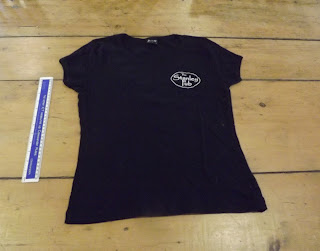I've had a fun morning up at the Athenaeum cataloging some t-shirts and baseball caps.
I basically used the same methodology as I used to document the contents of Dow's.
I photographed the object, in the case of a t-shirt, laid flat with a 30cm ruler in shot to give an indication of size
I photographed it front and back - in this case there was a larger version of the logo on the back, took close ups of the logo, the label and the internal label - you know, the itchy irritating one that's sewn into the seam.
I transcribed all these details onto an excel spreadsheet - size, gender, material, colour, details of logo and content of the labels. There's no particular reason to use excel, Libre Office or Google Sheets would have done as well, but excel is the default application and the people I'm working with expect everything to be done using Microsoft products.
In the case of baseball caps, it was more or less the same procedure, except I used a bit of white card as a background.
In retrospect, I should probably add a small photographic backdrop to my documentation kit for photographing larger objects.
All the images are stored together in a directory called Reference Images.
And then the fun part - packing the items. Prior to being placed in an archive box the items were wrapped in acid free paper. Multiple items were placed in a single archive box. In time the archive boxes will be given an accession number.
Besides this I also created a little markdown based reference guide. This is particularly useful as it allows us to record which items are stored in which archive box - this information is also added to the spreadsheet.
The items were donated by individuals in response to a community history event, with the exception of one t-shirt which came via a local op shop. Unfortunately no one thought to write down who donated what, (not quite true - people did make notes on scrap paper but it's not clear to which item which note refers) but I'm hoping that if I ask enough of my colleagues someone will remember who donated what which will allow us to record some provenance information.
It's also worth noting that there's no archive lab or anything involved - like at Dow's everything is carried in and out for each session - the portable surveying mode of working - and which I'm also adopting for Lake View ...



No comments:
Post a Comment